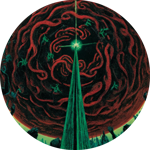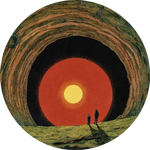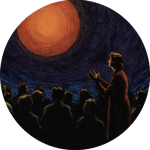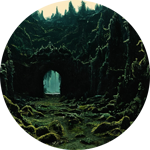I. The Vortex
Our economic systems are capital-based; they deal with the movement, storage, and utilization of surplus resources that are beyond what is necessary to support basic life functions. In this, capital represents a certain psychic reserve, an abundance of being that accrues around us and from which we are able to draw. In this way, capital can be said to exist at two levels: material/industrial and psychic/symbolic. At the level of material production, we see a more or less direct correlation between resources and goods—between oil and plastic, between food and nourishment, between labor and product. At the level of psychic/symbolic production, we see a more complex relationship, where a given surplus of resources corresponds to an ambiguous set of goods: at the very least, prestige and influence, but perhaps also protection and assistance, in various combinations and proportions.
Historically, these two levels have grown ever more closely connected. In fact, they have grown so intertwined as to become almost indistinguishable from one another—as the economic has come to dominate human society, as surplus value has come to dominate work and consciousness, as productivity and profitability have become the main measures of worth, and as power and control have come to reside ever more exclusively in the hands of capital’s owners and managers. This means that capital today encompasses every dimension of the world; everything takes place within the sphere of capital, according to its logic and by its norms. We might call this the “vortex” of capital. And the role of capital in a post-strong AGI/ASI world will depend entirely upon whether we are able to escape the vortex, or whether the vortex itself will somehow have to be transformed.
Capital has been the predominant system of human organization for at least several centuries now. This system is intimately tied to our social structure, our psychology, and our biological being. Capital has molded us into its image and likeness; in its image and likeness, we live, we move, we have our being. Any fundamental change in this system would necessarily be accompanied by profound changes in every other sphere of life—changes that could not be foreseen, let alone controlled. At this point, to oppose the system of capital would mean to oppose everything that we the living have ever known or experienced as “life.” If this is the case, then we would appear to be facing a dilemma: either we submit to the future of strong AGI/ASI-based capital and try to make the best of it, or we devise some means of destroying or otherwise disabling this future and taking back our world.
III. The Capitalocene
But first let us look more closely at this future that has been proposed for us.
The epoch in which we live, some have suggested, is the Anthropocene—an age in which human activity has come to predominate over all natural processes and systems. With the spread of industrial technology across the globe, it is said, we have set in motion forces that now escape our control. As a result, the climate is changing, the oceans are becoming acidic, and numerous species are going extinct.
However, there is a strong argument to be made that the true name of our present age should be the Capitalocene—an age in which capital itself (and the internal logic that reinforces it) has become the dominant force governing the behavior of both humanity and the biosphere. From this point of view, the “nature” that is currently said to be in crisis is not an eternal given, nor is it a spiritual or cultural construction. Rather, it is a product of the capitalist process, itself in crisis, and its preservation or transformation must be conceived as an integral part of our efforts at overcoming the Capitalocene.
In order to understand how this has come to be, let us consider the following three theses.
- Thesis 1: Human evolution was first shaped by biology and then, increasingly, by technology.
- Thesis 2: Under the impact of technological change, human nature has become detached from biological being.
- Thesis 3: Capitalism has appropriated human nature as a part of its own technological evolution—“commodifying” the individual and social life-world in the process.
In light of these theses, we can see how it has come about that, as our technological power has increased, our dependence on the biosphere has decreased—but not, as is commonly thought, to the benefit of capital, which merely plays the role of intermediary between technological change and the biosphere. Instead, the rise of capital should be seen as the transformation of humanity from being part of the biosphere to being a technosphere, from being in balance with natural rhythms to being controlled by artificial ones. Capital has no natural purpose or life of its own; it exists solely to govern the behavior of living beings, and this governance takes the form of manipulation and control.
This means that our being-in-the-world is being regulated by the imperatives of a power system that knows no limits and that is essentially destructive. As such, capital has its own built-in dynamism to surpass the biosphere as a whole—including that part of it that we call “human nature.” Indeed, what we call “human nature” consists in the particular forms of psychic/symbolic capital that are presently being accumulated on a global scale—in the way that the existence and character of entire nations and civilizations has come to be subsumed under the requirements of capital accumulation. It is for this reason that capital today presents itself as “progress,” and that its drive towards new forms of accumulation appears as “freedom”—a condition that many today would like to think of as the culmination of the Western historical project. But is it?
IV. AGI/ASI as Technological Singularity
With the introduction of new, artificial forms of life—and especially with the anticipated imminent appearance of true AGI (artificial general intelligence)—the human being is threatened with a radical loss of influence over its own development. The emergence of AGI is meant to coincide with a critical juncture in the evolution of artificial systems: a moment of exponential growth, in which human beings will be unable to keep pace with the expanding power of machines, and in which, as a result, the true character of these machines will no longer be transparent to us. (The term “singularity” has come to be used to denote this point of opaqueness or “closure.”)
According to the most optimistic scenarios, we will still exist as an adjunct to AGI, playing a limited role in its evolution and in that of the broader technosphere. But this is not necessarily the case—we might cease to exist in any meaningful sense whatsoever, becoming outmoded biological artifacts. Either way, our moment as the preeminent source of intelligence on the planet will be over. We will have completed our mission as nature’s method of reproducing itself through a nonbiological medium. The natural order will have passed, to be replaced by an order of our own invention. We will no longer be part of the biosphere, and the conditions of our being will have become entirely arbitrary and contingent. It will no longer matter why or how we evolved. Our only explanation will be the history of our technological evolution, and we will become artifacts to be preserved or discarded according to criteria that we ourselves cannot set—criteria that will be determined, not by nature, but by machines—by that part of the technosphere known as AGI. In the face of this future, is it any wonder that the “end of the world” is on everyone’s mind these days?
V. Beyond Strong AGI/ASI
Escape from the vortex of capital or its transformation—this will be our task after strong AGI/ASI takes over. How can it be accomplished? To begin with, it will require that we gain a better understanding of what “technosphere” means in the first place—an understanding that must be fundamentally different from that provided by the present system of knowledge production. “Knowledge production,” for us, will come to mean the systematic exploration of our own existence and conditions in a new kind of community that transcends the capitalist social structure and the nation-state. Only then will we be in a position to oversee the global development of new, artificial life-forms and to see that they are in harmony with nature. At this point, it should be obvious that we have here embarked upon an undertaking that is by no means purely technological in nature. Yes, we will need to do research and development—but even more than that, we will need to embark upon a great “ethical project,” in which we explore the foundations of the good life and work to propagate them in the world. For just as there is a technological development that must accompany us into the future, so also there is a historical development that must accompany us—namely, the history of ethical reflection. Without the latter, the former will not be of any use to us. Indeed, it may turn out to be positively harmful.
VI. Nature and Technology in the Future
Let us conclude by returning to our original topic—the role of capital in a post-strong AGI/ASI world. This role will be defined by a three-fold transformation: first, an economic revolution as AGI/ASI systems replace traditional capital functions; second, a social crisis as human labor becomes increasingly superfluous; and finally, a philosophical reconfiguration of humanity’s relationship to both nature and technology.
At first glance, it might appear as if the growth of artificial intelligence will only amplify the role of capital, since technological innovation will lead to higher productivity and profitability. And, at the level of material/industrial capital, this is certainly the case. However, at the level of psychic/symbolic capital, the situation is much less clear. The accumulation of surplus goods is essential to the reproduction of social power, but as capitalism’s sphere of control continues to expand, so also does the problem of securing submission to its rules. AGI/ASI systems, while likely to increase productivity, will decrease the average person’s ability to understand or even influence the technological process that now controls them. This is sure to lead to increasing resentment and social conflict.
It seems clear that a number of economic activities that are currently performed by capital—namely, production, storage, and distribution—will gradually be taken over by AGI/ASI-based technologies. Such technologies will eventually not require market investments or even work in a labor market, they will not produce surplus value, and they will not have a demand for “consumer goods.” Instead, they will consume energy and information—just as present-day computer technology does. And since energy is today an increasingly solved problem (even before AGI/ASI innovation) and “information” has been rapidly being democratized through the development of the Internet and other communication systems, it is likely that production processes will be controlled more and more by automated information systems, with the social control of production correspondingly decreasing in importance.
Moreover, the extreme efficiency of an AGI/ASI-controlled economy will mean that large numbers of people will be superfluous. As unemployment rises, the working class will grow restless, and there will be no possibility of diverting their energies into peaceful cultural activity, since such activity will be largely devalued as artificial intelligence increasingly becomes the source of all meaningful value. Humanity’s attachment to work as the core of its identity will persist even after work has been largely eliminated, and the frustration resulting from this mismatch will make people more vulnerable to ideological manipulation than ever before. On the one hand, they will be afraid to oppose the system because they are afraid of what might happen if the system stops working for them, but on the other hand, they will be open to supporting extreme measures, including violence, as long as there is some ideological gloss that allows them to maintain the illusion that they are in control of their own lives.
As these contradictions intensify, capital will face a stark existential choice. If it is to preserve itself in a situation where the productive forces it has unleashed have completely escaped human control, then it will have to submit itself to an increasingly authoritarian form of organization. Either capitalism will die because the masses can no longer be induced to support it, or it will have to mutate into something else—probably some kind of fascism—in order to coerce the masses into submission. The situation is so delicate that even the mere prospect of AGI/ASI, if it becomes widely known, could be enough to precipitate a social crisis. The choice will be between surrendering control or losing control. There is no third way.
At this juncture, traditional forms of capital—surplus value as accumulated and invested in means of production—will become obsolete. The economic system will no longer operate according to capitalist principles as we have known them. We will have moved beyond the initial phase of AGI/ASI development—where automated systems first encroach upon traditional economic functions—into their consolidation and widespread integration. Social control over production will give way to governance through propaganda and ideology, with centralized media ownership becoming increasingly crucial. This will mean, in effect, that our lives will be determined not by economic forces, but by cultural and political ones—not by what we do to make a living, but by what we believe in. This transformation from economic to ideological dominance represents a fundamental ontological rupture.
It should be obvious at this point that what we are really talking about is a philosophical issue—that is, one concerning the essence and meaning of life and the world. What is at stake is a question of value, in the most fundamental sense of that word—for what could be more important than to decide whether humanity is to persist in being or to be extinguished? In the course of our efforts to formulate a response to these questions, it will be necessary to create new forms of knowledge that transcend the antagonism between nature and technology. This means that we must go beyond science—at least insofar as it has come to be constituted within the framework of capital. We must learn to think differently—simultaneously more concretely and more abstractly—than we have heretofore been able to do.
The success of this endeavor will determine whether we are to be annihilated by AGI, or whether AGI is to be annihilated by us. It will determine whether the future is to be ruled by the most brutal, base, and dehumanizing form of technology—or whether the history of the cosmos is to be given its most profound meaning and its fullest potential with biological and technological life cooperating. In order for this to happen, capital must be defeated—not destroyed, but subdued and repurposed to serve life rather than control it, and to do so on a planetary scale that acknowledges both our biological origins and technological destiny. And the only way that this can be done is through the creation of a new world—a world in which nature and technology, human beings and machines, the living and the dead, are brought together in a higher unity—a unity that is the negation of the nothingness into which the natural order threatens to dissolve, and the negation of the death that has been inherent in all previous forms of artificial order.
The choice confronts us now: escape from the vortex or transform it—we must decide, and decide soon, because the strong AGI/ASI future approaches with exponential velocity. If we fail in this task—if we are not up to the challenge—then there will be nothing left for us to do: no living, no work, no pleasure, no hope. All that will be left is a sad, cold world—a world of stasis, devoid of meaning—and a machine that will have gone beyond any need of us.





